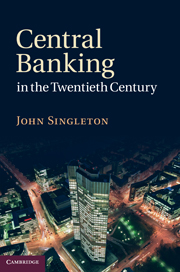Book contents
- Frontmatter
- Contents
- List of illustrations
- Acknowledgements
- List of abbreviations
- 1 A beginner's guide to central banking
- 2 Very boring guys?
- 3 Wind in the willows: the small world of central banking c. 1900
- 4 Something for everyone: new central banks, 1900–1939
- 5 A series of disasters: central banking, 1914–1939
- 6 The mysteries of central bank cooperation
- 7 The first central banking revolution
- 8 No time for cosmic thinkers: Central banking in the ‘Keynesian’ era
- 9 Rekindling central bank cooperation in the Bretton Woods era
- 10 The goose that lays the golden egg: Central banking in developing countries
- 11 The horse of inflation
- 12 The second central banking revolution: Independence and accountability
- 13 Reputations at stake: financial deregulation and instability
- 14 Inflation targeting: the holy grail?
- 15 The long march to European monetary integration
- 16 A world with half a million central bankers
- References
- Index
16 - A world with half a million central bankers
Published online by Cambridge University Press: 04 February 2011
- Frontmatter
- Contents
- List of illustrations
- Acknowledgements
- List of abbreviations
- 1 A beginner's guide to central banking
- 2 Very boring guys?
- 3 Wind in the willows: the small world of central banking c. 1900
- 4 Something for everyone: new central banks, 1900–1939
- 5 A series of disasters: central banking, 1914–1939
- 6 The mysteries of central bank cooperation
- 7 The first central banking revolution
- 8 No time for cosmic thinkers: Central banking in the ‘Keynesian’ era
- 9 Rekindling central bank cooperation in the Bretton Woods era
- 10 The goose that lays the golden egg: Central banking in developing countries
- 11 The horse of inflation
- 12 The second central banking revolution: Independence and accountability
- 13 Reputations at stake: financial deregulation and instability
- 14 Inflation targeting: the holy grail?
- 15 The long march to European monetary integration
- 16 A world with half a million central bankers
- References
- Index
Summary
This has been a central-banking century … the number of central banks has risen from 18 in 1900 to 172 in 1998. The world now has almost half a million central bankers.
The Economist (1998: 162)There seems to be a widespread perception that the global economy now stands on the brink, but the brink of what remains the question.
Bank for International Settlements (2000: 142)For the world of central banking, the twentieth century ended with the retirement of Alan Greenspan from the chairmanship of the Federal Reserve Board on 31 January 2006. At the time, Greenspan was widely believed to have been one of the most successful central bankers ever. Even Milton Friedman, a long-standing critic both of the Fed and of discretionary monetary policy, extolled Greenspan's deft monetary management in the 1990s (Nelson, E. 2007b). The Greenspan years witnessed several close misses with financial meltdown, including the 1987 stock market crash, emerging market crises in Asia, Latin America, and Russia, the Long-Term Capital Management (LTCM) fiasco in 1998, the dotcom implosion in the early 2000s, and the attacks on 11 September. Greenspan, the great helmsman, was credited with steering the ship away from the rocks each time. The praise heaped on him by many commentators, including academics (Kahn 2005), was also an endorsement of the central banking profession, which seemed to have triumphed over inflation, and appeared to be on the verge of implementing more effective techniques for averting and containing financial crises through Basel II.
With the onset of the first major financial and economic crisis of the twenty-first century in 2007–9 (Bordo 2008), the standard interpretation of recent financial history was brought into question.
- Type
- Chapter
- Information
- Central Banking in the Twentieth Century , pp. 277 - 288Publisher: Cambridge University PressPrint publication year: 2010



